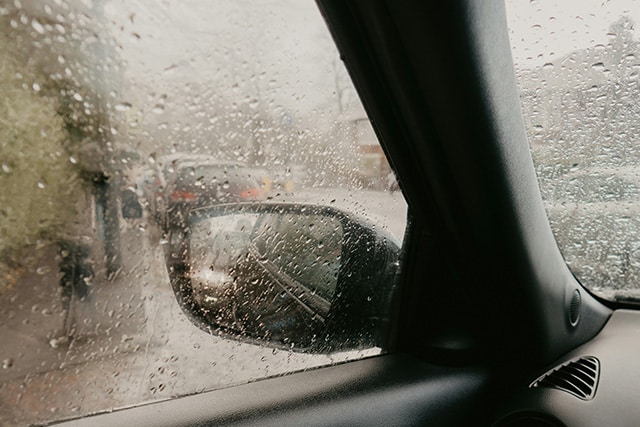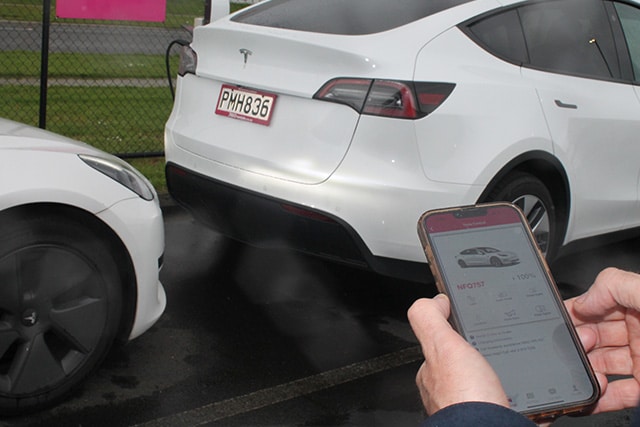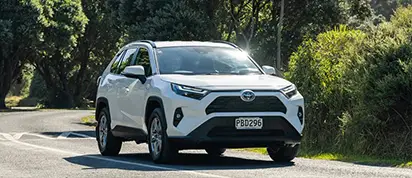Getting ready to kick off your New Zealand self-driving holiday is incredibly exciting. However, you might be feeling a little stressed at the thought of navigating unfamiliar roads in heavy rain.
It’s tricky to account for the weather, and sudden storms do happen, especially in New Zealand’s winter. While driving in wet weather can be dangerous, there is no need to panic or stress once the rain starts.
GO Rentals is here to help you safely and comfortably handle extreme weather on the road. Get GOing across New Zealand in confidence with our guide on how to drive safely in heavy rain.
Is it Safe to Drive in Heavy Rain?
Driving in heavy rain can present serious danger. However, with the proper preparation and changes to your driving, you can significantly reduce the risk it poses. Issues with driving in heavy rain include lowered visibility, slippery roads, potholes and large puddles.
Some of the most important ways to reduce risk when driving in heavy rain are:
- Driving slowly and gently.
- Avoiding sudden turns or movements.
- Maintaining a greater distance from other vehicles.
- Braking carefully.
What Speed to Drive in Heavy Rain
The best speed for heavy rain depends on how many other cars are on the road. Speed should be adjusted to keep a wide berth from other vehicles and to account for longer stopping distances.
A good rule is to keep your speed under 5km/hour in heavy rain. Driving faster than this reduces the control you have over your car.
Be especially cautious on New Zealand roads if it’s the first time it’s rained after a dry spell. The New Zealand Transport Agency advises additional caution just as it starts to rain, especially after a dry spell. Built-up oil and grease on the road will rise to the top of the water for the first 10 minutes of a heavy storm.
10 Tips for Driving in Heavy Rain
1. Check Your Car Regularly
Ensure your vehicle is ready for heavy rain to stay safe. Check the following parts of your car when storm clouds start forming:
- Tyres: Your tyres will need functional tread to clear any water from between the wheel and the road. Your car tyres should never be worn down to the 2.5mm or 3mm wear mark. If your tyres are worn down to this mark, replace them immediately. At GO Rentals we ensure our vehicles are in proper working order before you drive away.
- Wiper Blades: A constant downpour of rain will interfere with your visibility. Check that the wiper blades are working properly and have no signs of significant wear and tear. If windscreen wipers are leaving streaks on your windshield, they need to be replaced.
- Lights: In heavy rain, your vehicle will need to be seen by other drivers to avoid accidents. At GO Rentals we make sure our hire cars’ brake lights, hazard lights and headlights are in working order before they hit the road.
2. Maintain A Safe Distance
As your car has less control and braking power in the rain, you must give other vehicles plenty of distance on the road. The New Zealand Road Code recommends keeping at least four seconds of space between you and other vehicles when driving in rainy conditions.
A four-second gap will give you more time to hit the brake pedal and account for the slower stop. A good distance also keeps you out of other cars’ water spray, giving you better visibility.
3. Drive Slowly and Smoothly
Be gentle and cautious when driving during heavy rain or winter driving in New Zealand. Avoid sudden turns or sharp brakes to stay in control of your vehicle. If you do lose control of your vehicle, do not panic and stay calm.
Avoid twisting the wheel quickly to regain control or straighten your wheels, and do not brake sharply. This will destabilise the tyre’s grip as the wheels go in different directions.
Calmly and carefully reduce speed by putting your foot off the accelerator. Then turn your car into the slide to regain control of the vehicle. Slowly and gently apply the brakes once more control has been secured.
4. Maintain Visibility
Ensure you have as much visibility as possible during heavy rain. Keep your windscreen wipers on, turn on your lights and use your de-mister. Roads may have corroded during heavy rain and you must be able to see potholes, other cars and puddles.
If your visibility is too compromised or you feel incapable of driving in these conditions, stop as soon as possible.
5. Brake Carefully
It takes longer for your car to stop in heavy rain due to slippery surfaces. Braking too roughly in the rain can cause you to lose control of your vehicle.
Brake slowly and maintain a four-second gap between vehicles to safely drive in heavy rain. Make sure you are focused and vigilant so you can react quickly to hazards and changes in conditions.
6. Keep Your Tyres Inflated
If your tyre pressure is too low or too high, your vehicle will have reduced traction and less control during heavy rain. Your tyres may also take more damage or suffer premature damage and wear to the tread.
The best air pressure value for your vehicle can be found in the owner’s manual. Ensure your tyres are appropriately inflated at all times, especially when driving in the rain.
7. Use Your Lights
Keep your lights on when driving in heavy rain. This is not just to improve visibility, it ensures that other cars know where you are on the road.
Without rear and front lights on, other drivers will have more trouble seeing where you are on the road. As a result, they won’t be able to adjust their speed to accommodate your positioning.
You will also have more difficulty seeing the road, significantly increasing the risk of an accident.
8. Be Aware of Aquaplaning
Heavy rain on the road causes ‘aquaplaning’. Aquaplaning is when a layer of water between wet roads and your car makes all four tyres lose grip. Aquaplaning is caused by your tyres having too much or too little pressure, due to leaks, natural release or adding too much air.
Aquaplaning can be avoided by ensuring your tyres are at the right pressure, reducing your driving speed and turning off cruise control in heavy rain.
9. Use Your De-Mister
The interior of your car may start misting up during heavy rain, causing the windshield to fog up. Turn on your de-mister to ensure you have as much visibility as possible. If your vision is seriously compromised by a foggy windshield, safely pull over until your de-mister finishes defogging your car windows.
10. Watch Out For Spray
Spray from other vehicles, especially large vehicles will severely affect your visibility. Stay well behind other vehicles and if possible, position yourself to avoid any spray from their wheels.
What to do in a Flash Flood While Driving
Flash floods, floods caused by sudden heavy rain, are the most common type of natural disaster in New Zealand. Take the following steps if you are caught in a flash flood while driving:
- Be aware of rising water: Flash floods can happen quickly whenever the water levels start to rise. If you see the water level near you rising alarmingly fast, do not wait for an official announcement. Get to higher ground as soon as possible.
- Avoid fast-moving water: Stay clear of areas where flood water is deepest. Flood water can swell at any time. Avoid bridges, rivers or roads flooded with more than 15cm of water. If the water reaches this depth, your vehicle could stall or be swept away.
- Drive with caution: If it is necessary to drive through deep water, drive carefully. Move slowly and cautiously to avoid causing waves or flooding your vehicle’s engine bay with water.
- Stay informed: Stay up to date on immediate dangers or areas to avoid. Listen to the radio or check your Civil Defence Emergency Management Group Online.
Assessing Your Car After Heavy Rain or Flooding
Check over your vehicle once you are safely out of any flooding area, or once heavy rain doesn’t present any personal risk. Check the following features to ensure your car is safe to drive again:
- Brakes: Water from rain may have caused damage to your vehicle’s brakes. Brake pads require friction, and oil or moisture can interfere with your car’s braking capabilities. If your brakes are whining or your vehicle is taking longer to slow down, book repairs with a mechanic as soon as possible.
- Wheels: Rainwater may cause an excess of debris and sharp objects to rise to the road surface. After driving through heavy rain, check your tyres for cuts, punctures or other wear and tear. You should also clean off any mud or other debris to gain better traction and avoid further corrosion.
- Wiper blades: Functional wiper blades are a necessity in heavy rain or flooding. During extreme weather, your blades may be dirty, overworked or damaged. Check that your wipers are clean and not spreading grease, or scratching your windshield.
At GO Rentals, we want your car hire experience to be stress-free. That’s why we offer windscreen and tyre damage coverage in our Basic Insurance coverage.
Please be advised that, by insurance terms, drivers are responsible for any other damage to the hire car during heavy rains or floods. It’s best to avoid driving during heavy rain wherever possible.
Stay safe and do not take unnecessary risks during extreme weather conditions.
Heavy Rain Effects on a Car Battery
With heavy rain or flooding, water may have entered your car battery cover. This can cause serious damage to the wiring and insulation of your battery.
As a result, your battery may die and your car may stall. Make sure your car battery cover is fully intact before driving in heavy rain.
Driving a Tesla in Heavy Rain
Tesla vehicles use isolated, insulated and sealed circuitry in their electric engines. You may drive an electric car in heavy rain without risk of shocks or stalls.
It is still not recommended to drive a Tesla through 10cm deep flood water as it may lose control or be swept away. Additionally, traffic-aware cruise control does not adapt to extreme weather when active and is not recommended in heavy rain or flooding.
Charging A Tesla in Heavy Rain
It is safe to charge a Tesla in heavy rain without risk of shocks or electrocution. Tesla’s safety features automatically cut the power flow if it detects water in the port charger. It’s advised to cover the charge port when recharging your Tesla in the rain.
Do not charge an electric vehicle if there is a risk of flooding if the station isn’t adequately protected. The connector should not be left exposed to heavy rain, snow, or other weather for prolonged periods.
The Best Type of Cars for Heavy Rain
The best type of cars to handle heavy rain are vehicles with a higher build and greater weight, like SUVs and four-wheel drives (4WD).
SUVs are suitable for heavy rain because of the added weight and good ground clearance. SUVs also use tyres with higher degrees of tread than other vehicles. GO Rentals’ selection of SUVs includes the Mitsubishi ASX, the Mitsubishi Outlander and the Toyota Corolla Cross Hybrid.
4WD vehicles are made for safe and comfortable off-road travel and are safer to use on slippery roads than other vehicles. The added weight of the vehicle reduces the risk of aquaplaning, while the tyres are designed to have high levels of tread and grip.
However, in heavy rain, you should still drive more slowly and gently, even in a 4WD. Our Range of 4WDs at GO Rentals includes the Toyota Rav4 Hybrid, the Ford Wildtrak and the Mitsubishi Pajero Sport.
How to Check for Road Closures in New Zealand
You can find road closures across New Zealand by checking the New Zealand Transport Agency’s official traffic and travel information resource.
South Island Heavy Rain Road Closures
Official South Island road closures and safety notices during floods and heavy rain are announced on the New Zealand Transport Agency website. You can also check the official highway conditions tool to plan your journey before you hit the road.
Additionally, tune in to local radio stations for important updates and announcements.
North Island Road Closures Due to Heavy Rain
Important North Island road closures due to rain or flooding are announced by the New Zealand Transport Agency. Other road closures and highway conditions can be seen on the highway conditions tool. Be sure to plan your journey ahead of time during rainy seasons.
Announcements during floods and storms are also made over the radio.
GO Safely in Heavy Rain
Ready to get GOing on a safe and comfortable journey? We offer a wide array of versatile vehicles which can handle rainy weather and winter driving.
We also offer free Basic Insurance included in the price of all our rentals. You can also purchase higher levels of coverage for additional financial protection.
We also offer a Total Road Care package with all our rentals. This package ensures your journey is easy and stress-free. For just $3 a day, you’ll receive 24/7 roadside assistance for all types of breakdowns if you need it. We’ll also cover the cost of all government road taxes and toll road travel.
GO Rentals helps you traverse New Zealand in safety and comfort. From icy roads to heavy floods, we help you to feel confident and secure in the face of any obstacle.
Book your GO Rentals vehicle today, and we’ll find the perfect vehicle match for your winter adventures.
Book a vehicle for this trip
We recommend:
Intermediate 4×4 Hybrid
Toyota Rav4 AWD Hybrid




